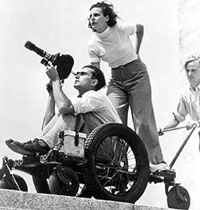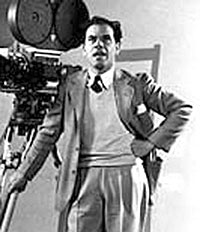 Over since moving film made it possible for celluloid to show motion for the first time, artists started using the novel medium for expression. In the beginning there was the fascination with the fluid movement, but it was expensive business. The documentary inevitably became the poor cousin of the budding movie industry. In the 1920s, the documentary had to depend on the propaganda budgets of governments, opposition parties, charitable organisations.
Over since moving film made it possible for celluloid to show motion for the first time, artists started using the novel medium for expression. In the beginning there was the fascination with the fluid movement, but it was expensive business. The documentary inevitably became the poor cousin of the budding movie industry. In the 1920s, the documentary had to depend on the propaganda budgets of governments, opposition parties, charitable organisations. One of the most striking early examples of government involvement in documentary film production is undoubtedly Leni Riefenstahl's Triumph of the Will. Where else but in Nazi Germany could an entire city have been mobilised just for the sake of a documentary! Hundreds of cameras recorded Hitler's descent through the clouds to boulevards lined with cheering devotees. The awesome power of the audio-visual media in bringing across a government-sponsored viewpoint had been discovered.
The world was soon plunged into war. The documentary became a part of the war effort. The Office of War Information in the United States drafted directors and cameramen to churn out upbeat documentaries on what the boys were up to on the front. The Memphis Belle and frontline footage from the Pacific brought the sacrifice and bravery of the troops to cinema houses throughout the country.
After World War II, Hollywood was into bigger things and the documentary fell from favour. There were still private organisations that made films like the pre-war The River or The City but since television had not made a debut, the documentary had to wait. When cathode rays dawned in the early 1950s, the documentary once more had an ideal medium of delivery but it was once more side-stepped. Just like Hollywood, television stations did not seem to want to have anything to do with controversy. Documentary films were in fact all about controversial comments on prevailing reality.
It was with the See it Now shows on CBS that the documentary in America finally got its chance. But even here, documentary filmmakers found it difficult to reconcile themselves to pressures from "above" to either tone down their comment or to drop some subjects altogether.
 Scaling down of the camera equipment to take 16mm film and the gradual miniaturisation of the sound equipment with the magnetic audiotape brought changes. As the equipment got less obtrusive and more portable, film producers could now venture into hitherto uncharted territory. As a direct legacy of the cinema verit? movement in Europe, the television documentary, too, became mobile. The advent of video and digital equipment advanced the genre of verit? now visible in documentaries, spot news footage, and yes, MTV.
Scaling down of the camera equipment to take 16mm film and the gradual miniaturisation of the sound equipment with the magnetic audiotape brought changes. As the equipment got less obtrusive and more portable, film producers could now venture into hitherto uncharted territory. As a direct legacy of the cinema verit? movement in Europe, the television documentary, too, became mobile. The advent of video and digital equipment advanced the genre of verit? now visible in documentaries, spot news footage, and yes, MTV. Verit? allowed documentary makers like Bob Drew and Richard Leacock, and shows like ABC Closeup to present films that made viewers feel they were there. We're all used to it now, but when it first came out, there was nothing like it. But in the obsession with actuality, many filmmakers influenced by Drew forgot the true role of the documentary-to make a social comment and have a voice of its own. Cinema verit? became an end in itself.
Just because a documentary "is there" it does not mean it shows the truth. Editing can show opposite views using same visuals. Frank Capra used Riefenstahl's footage of Hitler inWhy We Fight. While Hitler's fiery oratory was used powerfully by Riefenstahl to show his forceful personality, leadership and charisma, Capra used the same footage to expose Hitler as a ruthless demagogue. Both were making propaganda films.
Editing films never stopped being an issue. Critics of early television documentaries were against the powerful manner in which the juxtaposition of events could exaggerate or warp facts. When the American Ed Murrow and Fred Friendly duo started to take sides on issues and used editing techniques to effectively drive home their point, critics cried "foul". They felt it was fundamentally unfair that documentary film editors blot out truth with selected splicing. In their competitive zeal for prime-time news, the networks will focus in on a 20-second scuffle during a two-hour demonstration that passed peacefully. The blood-stricken face of a lone victim can fill a 16" screen in the living room. And now with the time allotted to documentaries becoming increasingly constricted, producers have been forced to edit out more and more. Truth is the first casualty.
The documentary still remains a powerful medium for comment on social issues, and intelligent editors can use it to expose injustice. Documentaries production costs have now plummeted, just about anyone can have a digital camera and edit film on computer.


